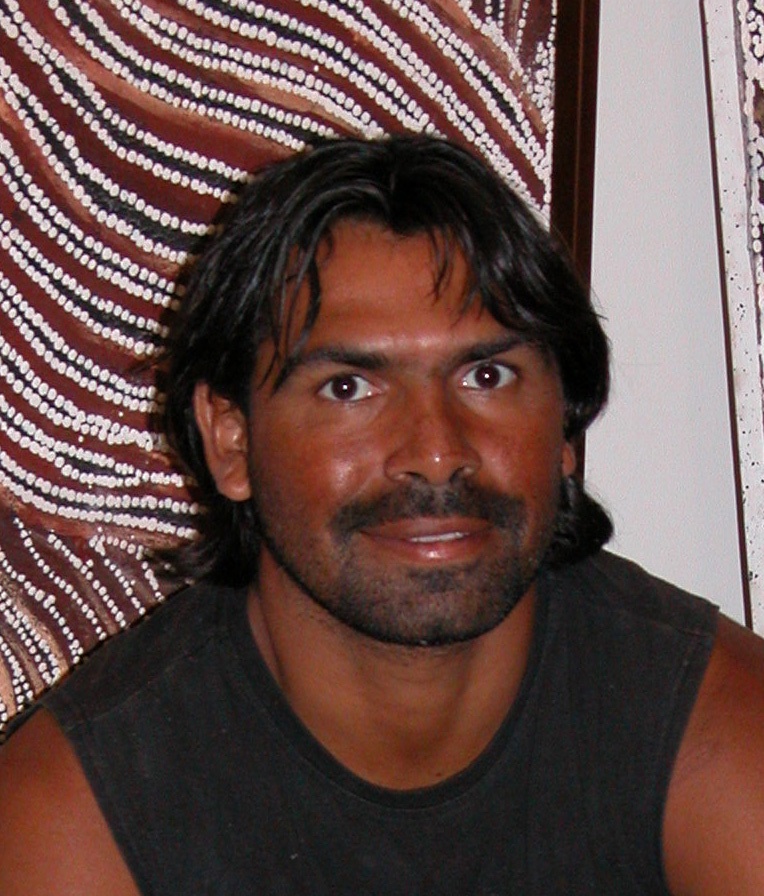Delivery from $80
Worldwide Shipping Available
Free Pickup from Seaforth NSW
Previous
Next
Acrylic on Canvas
83 x 63 cm Framed
A$4,800 Buy NowAcrylic on Canvas
140 x 100 cm
Sold SoldAcrylic on Canvas
140 x 100 cm
Sold SoldAcrylic on Canvas
80 x 60 cm
Sold SoldAcrylic on Canvas
80 x 60 cm
Sold SoldAcrylic on Canvas
100 x 80 cm
Sold SoldAcrylic on Canvas
120 x 90 cm
Sold SoldAcrylic on Canvas
120 x 90 cm
Sold SoldHaven't found what you're looking for?
Contact a consultant about other ways to acquire an artist's artwork.

BORN 1980
REGION Derby in North Western Australia
LANGUAGE Wangkajunga
Background
The day Wangkajunga artist Lloyd Kwilla was born, a tribal leader, healer and great bushman from his Sandy Desert region had died. According to Wangkajunga law, Kwilla therefore inherited both the man’s bush name and the leadership responsibilities that came with it. By the age of 31 he was a father of five and has been a community leader since the age of 18, dealing with a range of complex and often demanding issues with and for his Wangkajunga (Christmas Creek) community where he grew up and was schooled near Halls Creek in the East Kimberley on the northern edge of the Great Sandy Desert.
Kwilla’s tribal lands are those of his grandfather and father’s country, deep in the Great Sandy Desert and centered around Kuylayi, or Well 43, on the Canning Stock Route. It is from Kuylayi that Kwilla’s paintings emanate, as organic in their creation as is his caring for the land itself.
Kwilla started painting in 2000 when his father, the great healer, lawman and Great Sandy Desert artist Billy Thomas, aged and frail, stopped painting.
`My father, he said to me – it is your responsibility now, to go out there, to look after your country – to paint for it and to tell your children and people about our history and country,’ says Kwilla.
Kwilla’s first series, and one that remains an enduring theme, is that of bushfires. `These are really important to the land and our people,’ he says. ‘Every October the land gets scrubby and we need to burn it to make it live again – to clear paths for us to track through, to let the new growth come so that animals like bilbys and emus have new grass to eat.’
‘It’s like a circle, you know? The people look after the land, clear the waterholes, and encourage the plants to grow for our food and for the animals that we hunt for food. Take one thing out of that, the circle is broken and it all disappears.’
Kwilla’s paintings of waterholes (Jumu) in swirling rhythmic flow or more formal tracking is also a major painting theme of profound significance. ‘My father used to take me all over the land, telling me of the `big mob’ of waterholes – some that are under the sand – and about the paths he used to navigate without any signposts to know where the water was. This stuck in my mind and I’ve been thinking about how to paint it ever since.’
In Kwilla’s short painting life of less than 10 years, he has seen his works feature in successful and sell out exhibitions in Australia’s capital cities and London. An artist of serious intent he is, however, far from content to rest on past successes. Constantly he pushes his own stylistic boundaries and artistic exploration. Evident too in his recent work is an increasing confidence with the challenging medium of pure ochre. Some works show a formal, almost ritualistic iconography; others are more expressionistic – charcoal and white drifts of rainclouds, waterholes and meeting places as black smudges on the rain-soaked lands. Others feature sand ridges carved by the wind; yet others depict meandering land tracks fading until disappearing entirely into the earth itself.
In most he takes what seems to western eyes, an aerial perspective, but is in fact a `mind map’ of ancestral tracks that link waterholes and ceremonial sites. Colours are soft pinks, browns, whites and greys, gritty textured whites, blacks and, more recently, a rich chocolate, almost purple in hue, sourced directly from Kuylayi itself.
Kwilla’s recent work has also seen a shift – a confidence that comes with maturity and the rights to both hone imagery and conversely free it up in more painterly fashion.
Quietly meditative these distinctive, mesmeric paintings impress for their strong cultural integrity and high aesthetic merit. Made from the rich ochres of the earth itself, they invite the viewer into the heart of this timeless land to share Kwilla’s world and that of his forebears. `This is my grandfather’s and father’s gift to me, and my gift to my children and the world.’
Susan McCulloch OAM, Victoria, May 2011
EXHIBITIONS
2011 Trevor Victor Harvey Gallery
2008 Rebecca Hossack Gallery London
GROUP EXHIBITIONS
2011 Australasian Arts Projects 303 Singapore
The day Wangkajunga artist Lloyd Kwilla was born, a tribal leader, healer and great bushman from his Sandy Desert region had died. Continue reading
Continue readingSubscribe to recieve the latest updates from Lloyd Kwilla
Harvey Galleries was founded by the Harvey family in 1994 with an eye to establish a dynamic and inclusive contemporary art space on the North Shore of Sydney. For almost three decades we have expanded our reach to over three gallery locations and an ever expanding stable of the best artists Australia has to offer.
Harvey Galleries acknowledges the traditional custodians of the lands upon which our galleries stand. The Guringai people (Seaforth), the Gadigal people of the Eora Nation (Sydney), and the Bunurong Boon Wurrung and Wurundjeri Woi Wurrung peoples of the Eastern Kulin Nation (Melbourne).
We pay our respect to Elders past and present.
Always be the first to know about exhibitions, events and new art releases.